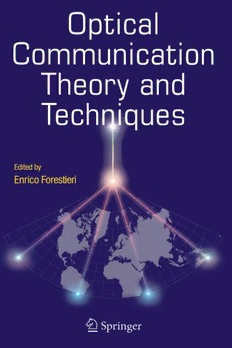
Optical communication theory and techniques PDF
Preview Optical communication theory and techniques
OPTICAL COMMUNICATION THEORY AND TECHNIQUES TTTThhhhiiiissss ppppaaaaggggeeee iiiinnnntttteeeennnnttttiiiioooonnnnaaaallllllllyyyy lllleeeefffftttt bbbbllllaaaannnnkkkk This page intentionally left blank OPTICAL COMMUNICATION THEORY AND TECHNIQUES Edited by ENRICO FORESTIERI Scuola Superiore Sant’Anna, Pisa, Italy Springer eBookISBN: 0-387-23136-6 Print ISBN: 0-387-23132-3 ©2005 Springer Science + Business Media, Inc. Print ©2005Springer Science + Business Media, Inc. Boston All rights reserved No part of this eBook maybe reproducedor transmitted inanyform or byanymeans,electronic, mechanical, recording, or otherwise, without written consent from the Publisher Created in the United States of America Visit Springer's eBookstore at: http://ebooks.kluweronline.com and the Springer Global Website Online at: http://www.springeronline.com Contents Preface ix Part I Information and Communication Theory for Optical Communications Solving the Nonlinear Schrödinger Equation 3 Enrico Forestieri and Marco Secondini Modulation and Detection Techniques for DWDM Systems 13 Joseph M. Kahn and Keang-Po Ho Best Optical Filtering for Duobinary Transmission 21 G. Bosco, A. Carena, V. Curri, and P. Poggiolini Theoretical Limits for the Dispersion Limited Optical Channel 29 Roberto Gaudino Capacity Bounds for MIMO Poisson Channels with Inter-Symbol Interference 37 Alfonso Martinez Qspace Project: Quantum Cryptography in Space 45 C. Barbieri, G. Cariolaro, T. Occhipinti, C. Pernechele, F. Tamburini, P. Villoresi Quantum-Aided Classical Cryptography with a Moving Target 53 Fabrizio Tamburini, Sante Andreoli, and Tommaso Occhipinti Part II Coding Theory and Techniques Channel Coding for Optical Communications 63 Sergio Benedetto and Gabriella Bosco Soft Decoding in Optical Systems: Turbo Product Codes vs. LDPC Codes 79 Gabriella Bosco and Sergio Benedetto Iterative Decoding and Error Code Correction Method in Holographic Data Storage 87 Attila Sütõ andEmõke Lõrincz vi Performance of Optical Time-Spread CDMA/PPM with Multiple Access and Multipath Interference 95 B. Zeidler, G. C. Papen, and L. Milstein Performance Analysis and Comparison of Trellis-Coded and Turbo-Coded Optical CDMA Systems 103 M. Kulkarni, P. Purohit, and N. Kannan Part III Characterizing, Measuring, and Calculating Performance in Optical Fiber Communication Systems A Methodology For Calculating Performance in an Optical Fiber Communications System 113 C. R. Menyuk, B. S. Marks, and J. Zweck Markov Chain Monte Carlo Technique for Outage Probability Evaluation in PMD-Compensated Systems 121 Marco Secondini, Enrico Forestieri, and Giancarlo Prati A Parametric Gain Approach to Performance Evaluation of DPSK/DQPSK Systems with Nonlinear Phase Noise 129 P. Serena, A. Orlandini, and A. Bononi Characterization of Intrachannel Nonlinear Distortion in Ultra-High Bit-Rate Transmission Systems 137 Robert I. Killey, Vitaly Mikhailov, Shamil Appathurai, and Polina Bayvel Mathematical and Experimental Analysis of Interferometric Crosstalk Noise Incorporating Chirp Effect in DirectlyModulatedSystems 151 Efraim Buimovich-Rotem and Dan Sadot On the Impact of MPI in All-Raman Dispersion-Compensated IMDD and DPSK Links 157 Stefan Tenenbaum and Pierluigi Poggiolini Part IV Modulation Formats and Detection Modulation Formats for Optical FiberTransmission 167 Klaus Petermann Dispersion Limitations in Optical SystemsUsing Offset DPSK 173 Jin Wang and Joseph M. Kahn IntegratedOptical FIR-Filters for Adaptive Equalization of Fiber Channel Impairments at 40 Gbit/s 181 M. Bohn, W. Rosenkranz, F. Horst, B. J. Offrein, G.-L. Bona, P. Krummrich Performance of Electronic Equalization Applied to Innovative Transmission Techniques 189 Vittorio Curri, Roberto Gaudino, and Antonio Napoli Contents vii Performance Bounds of MLSE in Intensity Modulated Fiber Optic Links 197 G. C. Papen, L. B. Milstein, P. H. Siegel, and Y. Fainman On MLSE Reception of Chromatic Dispersion Tolerant Modulation Schemes 205 Helmut Griesser, Joerg-Peter Elbers, and Christoph Glingener Author Index 213 Index 215 This page intentionally left blank Preface Since the advent of optical communications, a greattechnological effort has been devoted to the exploitation of the huge bandwidth of optical fibers. Start- ing from a few Mb/s single channel systems, a fast and constant technological development has led to the actual 10 Gb/s per channel dense wavelength di- vision multiplexing (DWDM) systems, with dozens of channels on a single fiber. Transmitters and receivers are now ready for 40 Gb/s, whereas hundreds of channels can be simultaneously amplified by optical amplifiers. Nevertheless, despite such a pace in technological progress, optical com- munications are still in a primitive stage if compared, for instance, to radio communications: the widely spread on-off keying (OOK) modulation format is equivalent to the rough amplitude modulation (AM) format, whereas the DWDM technique is nothing more than the optical version of the frequency di- visionmultiplexing (FDM) technique. Moreover, adaptive equalization, chan- nel coding or maximum likelihood detection are still considered something “exotic” in the optical world. This is mainly due to the favourable charac- teristics of the fiber optic channel (large bandwidth, low attenuation, channel stability, ...), which so far allowed us to use very simple transmission and detection techniques. But now we are slightly moving toward the physical limits of the fiber and, as it was the case for radio communications, more sophisticated techniques will be needed to increase the spectral efficiency and counteract the transmis- sion impairments. At the same time, the evolution of the techniques should be supported, or better preceded, by an analogous evolution of the theory. Look- ing at the literature, contradictions are not unlikely to be found among different theoretical works, and a lack of standards and common theoretical basis can be observed. As an example, the performance of an optical system is often given in terms of different, and sometimes misleading, figures of merit, such as the error probability, the Q-factor, the eye-opening and so on. Under very strict hy- potheses, there is a sort of equivalence among these figures of merit, but things drastically change when nonlinear effects are present or different modulation formats considered.
